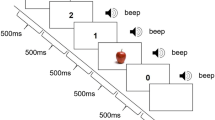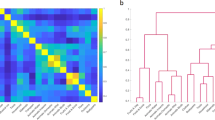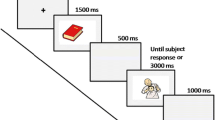Abstract
The processing of two spatial terms which refer to proximity and distance, near and far, was investigated in a word-picture comparison task. Two alternative hypotheses were tested, one based on the notion of linguistic markedness and supporting the positive status of far, and the other based on semantic-pragmatic factors and proposing that near is the positive member of the pair. An analysis of the true-false decision latencies indicated that near was generally verified faster than far in judgments in which the terms were used to describe both ego-to-object and object-to-object distance. A third experiment addressed the question of whether the advantage obtained in the verification of near may be accounted for in terms of the priority of the interpersonal dimension of representation relative to the objective one. The results are discussed with regard to the semantic representation of the two words.
Similar content being viewed by others

References
Bierwisch, M. Some semantic universals of German adjectivals.Foundations of Language, 1967,3, 1–36.
Chase, W. G., & Clark, H. H. Semantics in the perception of verticality.British Journal of Psychology, 1971,62, 311–326.
Clark, H. H. Space, time, semantics, and the child. In T. Moore (Ed.),Cognitive development and the acquisition of language. New York: Academic Press, 1973.
Clark, H. H. Semantics and comprehension. In T. A. Sebeok (Ed.),Current trends in linguistics XII: Linguistics and adjacent arts and sciences. The Hague: Mouton, 1974.
Clark, H. H., Carpenter, P. A., & Just, M. A. On the meeting of semantics and perception. In W. G. Chase (Ed.),Visual information processing. New York: Academic Press, 1973.
Gruber, J. S.Lexical structures in syntax and semantics. Amsterdam: North Holland, 1976.
Lyons, J.Semantics (Vol. 2). Cambridge: Cambridge University Press, 1977.
Miller, G. A., & Johnson-Laird, P. N.Language and perception. Cambridge University Press, 1976.
Osgood, C. E., May, W. H., & Miron, M. S.Cross cultural universals of affective meaning. Urbana, Illinois: University of Illinois Press, 1975.
Osgood, C. E., Sucy, G. J., & Tannenbaum, B. H.Measurement of meaning. Urbana, Illinois: University of Illinois Press, 1957.
Seymour, P. H. K. Response latencies in judgments of spatial location.British Journal of Psychology, 1969,60, 31–39.
Seymour, P. H. K. Semantic equivalence of verbal and pictorial displays. In R. A. Kennedy & A. L. Wilkes (Eds.),Studies in long term memory. London: Wiley, 1975.
Seymour, P. H. K.Human visual cognition: A study in experimental cognitive psychology. London: Collier Macmillan, 1979.
Seymour, P. H. K. Perceptual and judgmental bias in classification of word-shape displays.Acta Psychologica, 1971,35, 416–477.
Author information
Authors and Affiliations
Rights and permissions
About this article
Cite this article
Colombo, L., Seymour, P.H.K. Semantic and pragmatic factors in the representation of “near” and “far”. J Psycholinguist Res 12, 75–92 (1983). https://doi.org/10.1007/BF01067405
Accepted:
Issue Date:
DOI: https://doi.org/10.1007/BF01067405



